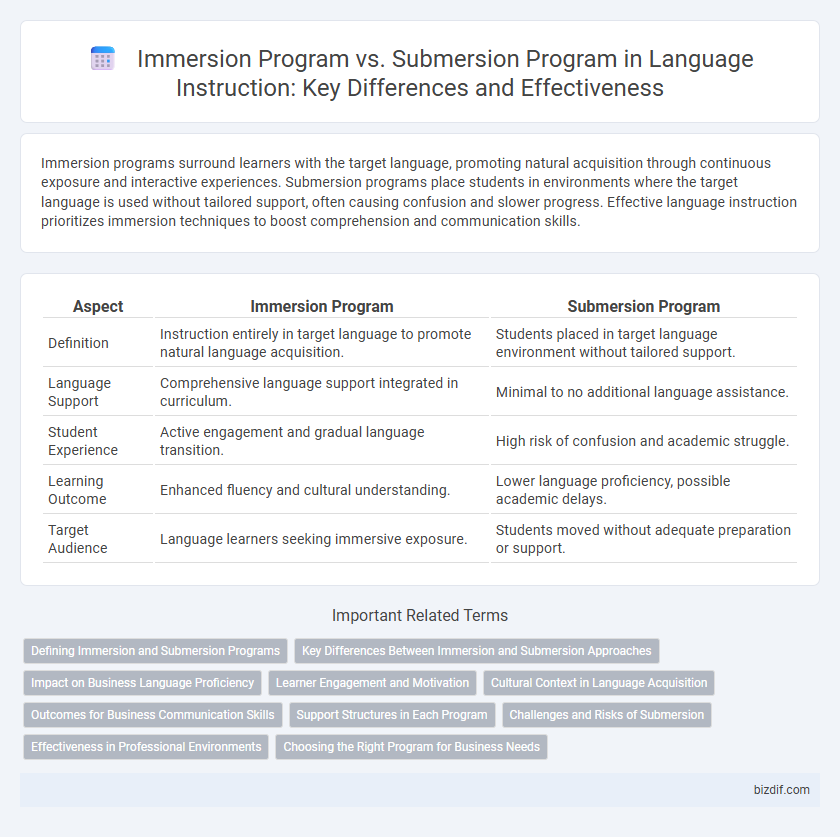Immersion programs surround learners with the target language, promoting natural acquisition through continuous exposure and interactive experiences. Submersion programs place students in environments where the target language is used without tailored support, often causing confusion and slower progress. Effective language instruction prioritizes immersion techniques to boost comprehension and communication skills.
Table of Comparison
| Aspect | Immersion Program | Submersion Program |
|---|---|---|
| Definition | Instruction entirely in target language to promote natural language acquisition. | Students placed in target language environment without tailored support. |
| Language Support | Comprehensive language support integrated in curriculum. | Minimal to no additional language assistance. |
| Student Experience | Active engagement and gradual language transition. | High risk of confusion and academic struggle. |
| Learning Outcome | Enhanced fluency and cultural understanding. | Lower language proficiency, possible academic delays. |
| Target Audience | Language learners seeking immersive exposure. | Students moved without adequate preparation or support. |
Defining Immersion and Submersion Programs
Immersion programs involve teaching students primarily in the target language, fostering natural language acquisition by surrounding learners with consistent, meaningful communication in that language. Submersion programs place non-native speakers in mainstream classrooms with minimal language support, expecting them to assimilate language skills passively through exposure. Immersion emphasizes active language use and cognitive engagement, whereas submersion often results in language barriers due to insufficient instructional adaptation.
Key Differences Between Immersion and Submersion Approaches
Immersion programs emphasize teaching students in a target language to promote fluency and cultural understanding, while submersion programs place non-native speakers in mainstream classrooms without specialized language support. Immersion prioritizes content-based instruction and active engagement in the second language, whereas submersion often leads to language barriers and limited comprehension. Research shows immersion learners achieve higher proficiency and academic success compared to submersion counterparts.
Impact on Business Language Proficiency
Immersion programs significantly enhance business language proficiency by providing intensive, context-rich environments that promote practical communication skills critical for professional settings. Submersion programs often overwhelm learners without structured support, leading to slower language acquisition and reduced confidence in business interactions. Effective immersion fosters cultural nuances and industry-specific terminology, accelerating fluency essential for successful global business operations.
Learner Engagement and Motivation
Immersion programs significantly enhance learner engagement and motivation by surrounding students with the target language in meaningful contexts, fostering natural communication and cultural understanding. In contrast, submersion programs often lead to student frustration and withdrawal due to lack of support, as learners struggle to keep up with content delivered exclusively in the new language. Research indicates that immersive settings promote higher retention rates and intrinsic motivation by encouraging active participation and contextual learning.
Cultural Context in Language Acquisition
Immersion programs enhance language acquisition by integrating cultural context into daily communication, promoting authentic understanding and practical use of the target language. Submersion programs often isolate learners without adequate cultural support, leading to challenges in fully grasping nuanced cultural meanings and social cues. Embedding cultural context within immersion settings facilitates deeper cognitive connections and long-term language proficiency.
Outcomes for Business Communication Skills
Immersion programs in language instruction significantly enhance business communication skills by fostering practical fluency and cultural competence through consistent exposure and active usage in real-world scenarios. Submersion programs often lead to initial confusion and slower language acquisition, hindering effective communication in professional contexts. Employers report higher proficiency and confidence in employees who complete immersion programs, resulting in improved negotiation, presentation, and interpersonal communication capabilities.
Support Structures in Each Program
Immersion programs provide structured support through bilingual teachers, scaffolding techniques, and culturally relevant materials to enhance language acquisition and content comprehension. Submersion programs often lack targeted support, placing students in mainstream classrooms with native speakers, leading to challenges in both linguistic and academic progress. Effective immersion support structures promote gradual language development, fostering confidence and academic success in second language learners.
Challenges and Risks of Submersion
Submersion programs often pose significant challenges, including limited language comprehension that hinders academic progress and emotional stress from feeling isolated. Students may experience increased frustration and decreased motivation due to lack of tailored language support. Risks involve long-term negative impacts on self-esteem and cognitive development without adequate intervention.
Effectiveness in Professional Environments
Immersion programs enhance language proficiency by integrating learners into environments where the target language is exclusively used, fostering rapid and context-rich acquisition ideal for professional settings. Submersion programs often result in slower language development and increased frustration, as learners receive little structured support, hindering effective communication skills essential for workplace success. Research indicates immersion participants demonstrate superior fluency and cultural competence, critical for navigating diverse professional environments efficiently.
Choosing the Right Program for Business Needs
Immersion programs create an environment where learners are surrounded by the target language, promoting natural acquisition and practical usage, which is ideal for businesses seeking employees with strong conversational and cultural fluency. Submersion programs place learners in target language settings with minimal support, demanding rapid adaptation but often causing initial comprehension challenges, suitable for companies needing quick language proficiency under pressure. Selecting the right program depends on organizational goals, workforce language baseline, and the desired balance between supportive learning and immersive experience.
Immersion program vs Submersion program Infographic

 bizdif.com
bizdif.com